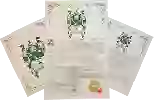
Winery RochegudeCôtes du Rhône
This wine generally goes well with
Details and technical informations about Winery Rochegude's Côtes du Rhône.
Discover the grape variety: Camaralet
The white Camaralet is a grape variety that originated in France (Pyrénées-Atlantiques). It produces a variety of grape specially used for wine making. It is rare to find this grape to eat on our tables. The white Camaralet can be found cultivated in these vineyards: South-West, Languedoc & Roussillon, Cognac, Bordeaux, Provence & Corsica, Rhone Valley.
Informations about the Winery Rochegude
The Winery Rochegude is one of of the world's great estates. It offers 25 wines for sale in the of Côtes-du-Rhône to come and discover on site or to buy online.
The wine region of Côtes-du-Rhône
The wine region of Côtes-du-Rhône is located in the region of Rhône méridional of Rhone Valley of France. Wineries and vineyards like the Château de Beaucastel or the Chateau de Fonsalette produce mainly wines red, white and pink. The most planted grape varieties in the region of Côtes-du-Rhône are Mourvèdre, Viognier and Marsanne, they are then used in wines in blends or as a single variety. On the nose of Côtes-du-Rhône often reveals types of flavors of pineapple, red plum or sour cherry and sometimes also flavors of truffle, juniper or clove.
The wine region of Rhone Valley
The Rhone Valley is a key wine-producing region in Southeastern France. It follows the North-south course of the Rhône for nearly 240 km, from Lyon to the Rhône delta (Bouches-du-Rhône), near the Mediterranean coast. The Length of the valley means that Rhône wines are the product of a wide variety of soil types and mesoclimates. The viticultural areas of the region cover such a distance that there is a widely accepted division between its northern and southern parts.
The word of the wine: Roast
Specific character given by noble rot to sweet wines, which results in a candied taste and aroma.














